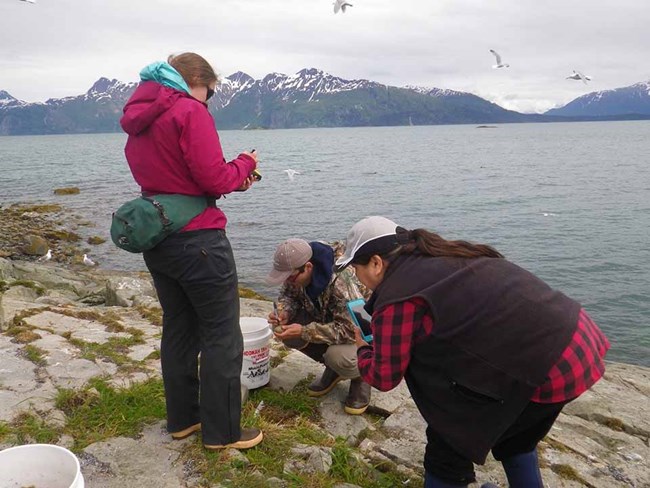Last updated: November 16, 2018
Article
Resuming Gull Egg Harvests

NPS/Tania Lewis
Park managers and the Hoonah Indian Association are experimenting with egg
harvests to determine best-practices and potential impacts on gulls and other
nesting birds, while at the same time providing eggs to Hoonah community
members. In early June 2017, tribal members conducted the second experimental Glaucous-winged Gull egg harvest in the park. The research aim was to determine whether egg quality, as determined by people consuming the eggs, varies depending on the number of eggs present in a nest. Glaucous-winged Gulls typically lay three eggs over the course of five days and begin incubating once the clutch is complete. Eggs do not begin to develop into chicks until incubation begins. For this reason, eggs from three-egg nests may be further developed than eggs from nests with 1 or 2 eggs and less desirable.
Glaucous-winged Gull (Larus glaucescens) Monitoring in Preparation for Resuming Native Egg Harvest in Glacier Bay National Park
Abstract
Glacier Bay National Park, Alaska, is the ancestral homeland of the Huna Tlingit people, for whom Glaucous-winged Gull Larus glaucescens eggs were an important cultural food source until the 1960s, when the National Park Service (NPS) began to enforce regulations prohibiting harvest. Over the past 20 years, NPS has sponsored several studies as well as a Legislative Environmental Impact Statement to assess the cultural and biological impacts of egg harvests. Based on these findings, the US Congress passed legislation in 2014 authorizing harvest of Glaucous-winged Gull eggs in Glacier Bay National Park. With the long-awaited passage of this legislation, egg harvest may begin as soon as the NPS promulgates the necessary regulations and an annual harvest plan is developed. In preparation for egg harvest, we used ground- and vessel-based surveys to determine 1) the distribution and abundance of nesting gulls, 2) egg-laying phenology, 3) nesting vegetation, and 4) potential impacts of egg harvest on other species. During 2012–2015, we repeatedly surveyed 20 islands and sections of shoreline in Glacier Bay (that were likely colony locations based on historic observations) for gulls and found six potential egg-harvest colonies. The number of nests per colony ranged from 22 to 174. The number of nests at each colony remained consistent among years, whereas the number of eggs showed high interannual variability. Other species observed that could be affected by egg harvest included hauled-out marine mammals and other seabirds nesting nearby. The majority of nests (67%) were found in graminoid vegetation, an early successional state. This study marks the beginning of long-term monitoring of the population parameters to infer potential impacts of gull-egg harvest in Glacier Bay and to manage the harvest. In addition to yearly monitoring of productivity, research on nesting habitat shifts, food availability, and predation could improve the park’s ability to understand any impacts of egg harvest on the distribution and abundance of Glaucous-winged Gulls in Glacier Bay National Park.
Lewis, T. M., C. Behnke, and M. B. Moss. 2017. Glaucous-winged Gull (Larus glaucescens) monitoring in preparation for resuming native egg harrvest in a national park. Marine Ornithology 45:165-174.
